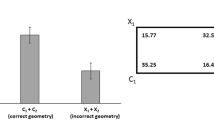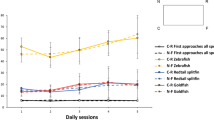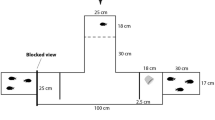Summary
-
1.
The swimming behavior of blind cave fish (Anoptichthys jordani) differs in familiar and unfamiliar surroundings. Following release in unfamiliar surroundings, or after alterations of a familiar environment, the fish increase swimming velocity in order to optimize lateral line organ stimulation. Furthermore, they glide along boundary features more often than they do in familiar surroundings. These characteristics of swimming behavior were used to measure the occurrence and duration of exploratory behavior.
-
2.
Fish removed from a familiar environment for as long as 2 days spend less time exploring when returned than when they were initially placed in the environment. After a longer absence no difference was found between the duration of the initial and subsequent exploration.
-
3.
When blind cave fish were anesthetized by cooling after 4 h of exploration in a novel environment, they explored the environment anew following recovery from anesthesia. However, when anesthetized after 6 or 30 h of exposure to the environment, renewed exploration was not observed.
-
4.
The shape of the tank was found to determine the duration of the fish's exploration. Bilaterally symmetrical tanks were explored longer than tanks with no axis of symmetry, even if the axis of symmetry is destroyed by relatively small objects, such as bars attached to the walls of the tank.
-
5.
The data presented support the hypothesis that during exploration, blind cave fish develop an internal (cognitive) map of their environment that contributes to subsequent spatial orientation.
Similar content being viewed by others
Abbreviations
- ECS :
-
electroconvulsive shock
- LLO :
-
lateral line organ
- LTM :
-
long-term memory
- STM :
-
short-term memory
References
Aronson LR (1951) Orientation and jumping behavior in the gobiid fishBathygobius soporator. Am Mus Novitates 1586:1–22
Aronson LR (1971) Further studies on orientation and jumping behavior in the gobiid fishBathygobius soporator. Ann NY Acad Sci 188:359–377
Campenhausen C von, Riess I, Weissert R (1981) Detection of stationary objects by the blind cave fishAnoptichthys jordani (Characidae). J Comp Physiol 143:369–374
Davis RE, Bright PJ, Agranoff BW (1965) Effect of ECS and pyromycin on memory in fish. J Comp Physiol Psychol 60:162–166
Hassan ES (1985) Mathematical analysis of the stimulus for the lateral line organ. Biol Cybern 52:23–36
Hinde RA (1966) Animal behavior — A synthesis of ethology and comparative physiology. McGraw-Hill, New York
O'Keefe J, Nadel L (1978) The hippocampus as a cognitive map. Clarendon Press, Oxford
Olton DS, Becker JT, Handelmann GE (1979) Hippocampus, space and memory. Behav Brain Sci 2:313–365
Schneider AM, Plough M (1983) Electroconvulsive shock and memory. In: Deutsch JA (ed) The physiology of memory. Academic Press, New York, pp 351–365
Teyke T (1985) Collision and avoidance of obstacles in blind cave fishAnoptichthys jordani (Characidae). J Comp Physiol A 157:837–843
Teyke T (1988) Flow field, swimming velocity and boundary layer: parameter which affect the stimulus for the lateral line organ in blind fish. J Comp Physiol A 163:53–61
Welker WI, Welker J (1958) Reaction of fish (Eucinostomus gula) to environmental changes. Ecology 39:283–288
Wickler W (1957) Vergleichende Untersuchungen an Grundfischen; I. Beiträge zur Biologie, besonders zur Ethologie vonBlennius fluviatilis Asso im Vergleich zu einigen anderen Bodenfischen. Z Tierpsychol 14:393–428
Author information
Authors and Affiliations
Rights and permissions
About this article
Cite this article
Teyke, T. Learning and remembering the environment in the blind cave fishAnoptichthys jordani . J. Comp. Physiol. 164, 655–662 (1989). https://doi.org/10.1007/BF00614508
Accepted:
Issue Date:
DOI: https://doi.org/10.1007/BF00614508




